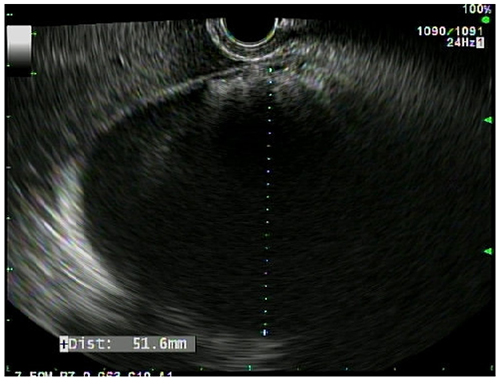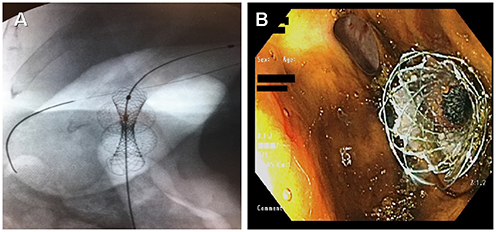Korean J Gastroenterol.
2018 Aug;72(2):83-85. 10.4166/kjg.2018.72.2.83.
A Guidewire May Save the Day
- Affiliations
-
- 1Department of Internal Medicine, Division of Gastroenterology, St. John Hospital and Medical Center, Detroit, MI, USA. drgargrajat@gmail.com
- 2Department of Internal Medicine, Division of Hepatology, St. John Hospital and Medical Center, Detroit, MI, USA.
- KMID: 2418768
- DOI: http://doi.org/10.4166/kjg.2018.72.2.83
Abstract
- Endoscopic gallbladder drainage (EGBD) has been used to treat acute cholecystitis or to relieve malignant biliary obstruction as an alternative to percutaneous gallbladder drainage and patient's are poor surgical candidates. This is currently being performed by placement of lumen apposing metallic stent (LAMS) with electrocautery mounted tip delivery system also called as "hot" technique. We had reported a case of self-expanding metallic stent (SEMS) within LAMS after stent migration during EGBD using "hot" technique and propose routine use of guidewire in patients undergoing the procedure.
Keyword
MeSH Terms
Figure
Reference
-
1. Patil R, Ona MA, Papafragkakis C, Anand S, Duddempudi S. Endoscopic ultrasound-guided placement of the lumen-apposing self-expandable metallic stent for gallbladder drainage: a promising technique. Ann Gastroenterol. 2016; 29:162–167.
Article2. Xu MM, Kahaleh M. EUS-guided transmural gallbladder drainage: a new era has begun. Therap Adv Gastroenterol. 2016; 9:138–140.
Article3. de la Serna-Higuera C, Pérez-Miranda M, Gil-Simón P, et al. EUS-guided transenteric gallbladder drainage with a new fistula-forming, lumen-apposing metal stent. Gastrointest Endosc. 2013; 77:303–308.
Article4. Law R, Grimm IS, Stavas JM, Baron TH. Conversion of percutaneous cholecystostomy to internal transmural gallbladder drainage using an endoscopic ultrasound-guided, lumen-apposing metal stent. Clin Gastroenterol Hepatol. 2016; 14:476–480.
Article5. Irani S, Ngamruengphong S, Teoh A, et al. Similar efficacies of endoscopic ultrasound gallbladder drainage with a lumen-apposing metal stent versus percutaneous transhepatic gallbladder drainage for acute cholecystitis. Clin Gastroenterol Hepatol. 2017; 15:738–745.6. Khan MA, Atiq O, Kubiliun N, et al. Efficacy and safety of endoscopic gallbladder drainage in acute cholecystitis: is it better than percutaneous gallbladder drainage? Gastrointest Endosc. 2017; 85:76–87.e3.
Article7. Chan JHY, Teoh AYB. Current status of endoscopic gallbladder drainage. Clin Endosc. 2018; 51:150–155.
Article8. Dollhopf M, Larghi A, Will U, et al. EUS-guided gallbladder drainage in patients with acute cholecystitis and high surgical risk using an electrocautery-enhanced lumen-apposing metal stent device. Gastrointest Endosc. 2017; 86:636–643.9. Teoh AYB, Serna C, Penas I, et al. Endoscopic ultrasound-guided gallbladder drainage reduces adverse events compared with percutaneous cholecystostomy in patients who are unfit for cholecystectomy. Endoscopy. 2017; 49:130–138.
Article
- Full Text Links
- Actions
-
Cited
- CITED
-
- Close
- Share
- Similar articles
-
- Guidewire Impaction in the Main Pancreatic Duct in a Patient with Chronic Pancreatitis: A Case Report
- Usefulness of the double-guidewire technique for endoscopic procedures in the field of biliary and pancreatic diseases
- Fracture of J-tipped guidewire during central venous catheterization and its successful removal under fluoroscopic guidance: A case report
- Guidewire Breakage: An Unusual Complication of Anterior Odontoid Cannulated Screw Fixation
- A complication of subclavian venous catheterization: extravascular kinking, knotting, and entrapment of the guidewire: A case report





